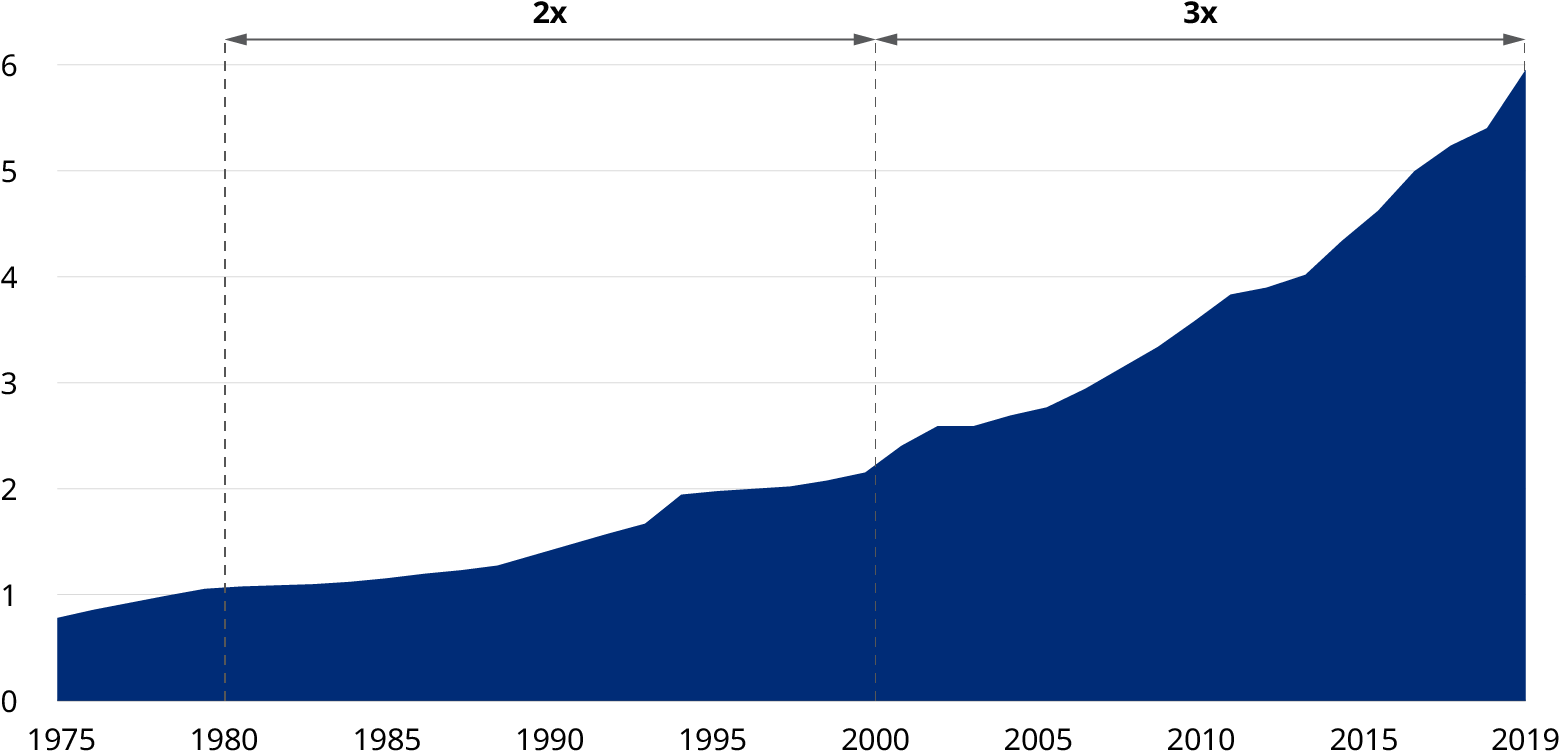As a result of globalization and the rise of emerging economies, the world has witnessed the golden age of international tertiary education, with a compound annual growth rate (CAGR) of about 5.5% in the past three decades.
The global pandemic, accompanied by the booming adoption of remote education solutions, has hampered the mobility of international students. Moreover, with governments, institutions, and students trying to navigate a coexistence with the virus, the world has adjusted to the new normal. Even so, while Zoom might facilitate the delivery of instruction, it cannot replicate full personal experiences, nor provide a clear pathway to host countries’ job markets, a factor upon which many foreign students weigh heavily in their equation of studying abroad.
With all of this in mind, the question is whether the sustained growth of international tertiary education can continue in the coming years.

Note: Total enrolment is defined as all the number of tertiary education students who are pursuing degree programs out of home country at corresponding year, instead of students who commence studying abroad at a specific year.
Globalization has provided higher information transparency, lowered the barriers of talent flow, and raised the need of talents with multicultural backgrounds. English-speaking countries, with strong economic power and higher education capacity, had become the most attractive destinations for international tertiary education.
Looking at a snapshot of 2019, four leading destination countries, namely, the US, the UK, Australia and Canada accounted for approximately 35% of total global tertiary education enrolment. China and India contributed to 50% of the new intakes of these four countries.
Notes:
1. Destination data are only available since 2012 for Japan, hence Japan data were not shown in 2002 landscape.
2. For UK, Vietnam students inflow number were not disclosed in 2002, hence Vietnam data were merged in "Other" category for UK.
Future Expectations for China’s Role
China, the single largest sending country of transnational students, has seen strong and robust growth of student outflow in the past two decades. However, catalyzed by the pandemic and the changing world order, China’s role has been evolving. The country’s availability of university seats is rising, and it has also become increasingly attractive as an education hub.
For Chinese students, the rewards of studying abroad, defined as the premium over studying in China, are gradually declining. With the wage premium shrinking, tertiary education capacity constraints loosening, and access to international-quality education at home increasing, the only push factor remained is the growing base of affordable population (partially offset by declining tertiary population). Simultaneously, with the new geopolitical background, regulatory headwinds and government intervention are expected to further guide the development of the industry.
As a result, we expect the total number of Chinese students in overseas higher education degree programs to peak within five years, and then enter a track of stagnation or even slight decline.
The Outlook of International Tertiary Education
The global international education market will generally continue thriving, driven by the robust demand expected from emerging markets, such as India, Vietnam, and Brazil. In the coming decade, we anticipate the mobility volume of international tertiary education towards the four largest destination countries of the US, the UK, Australia, and Canada to continue to grow at a CAGR of 2% to 3%.
Yet, the overall willingness to study abroad might have weakened across the globe compared to a decade ago. Depressed economic prospects and the rise of nationalism may drive future generations to think more thoroughly and practically before deciding to study overseas, especially in the face of the rising costs to do so, shadowed as well by increasing uncertainties in terms of expected income and the narrowing chances of emigration.
Implications for Higher Education Institutions
Universities are at a crucial crossroads, where they either transform or get left behind by disruptors. To remain relevant, they may need to start taking action in the following areas:
Launch a re-assessment of the academic portfolio. They should ensure their academic offerings are adequately adapted to equip students with life-long learning capabilities and to prepare them for the professional world. Schools may build a long-term monitoring mechanism to look into education outcome data, students’ performance and job placement results, and the feedback of their graduates, so as to make continuous amendments as needed.
Develop a technology strategy. Not limited to online course delivery or formative assessments, the strategy should be embedded into the whole customer journey so as to help elevate the value of both the education and the overall customer experience. For example, there could be a distance-learning platform that ensures interactive and captivating experiences for students on and off campus, virtual and augmented technology that enhances students’ learning experiences in the lab, artificial intelligence that helps achieve personalized education arrangements, etc.
Explore various formalities and outcomes of skills-based training. By offering a mixture of credentials, degrees, certificates, and capability badges, students and their prospective employers can better navigate their skillsets and recognize avenues for upskilling. Universities should also explore how they can provide support for students’ upskilling and even track-switching along their careers.
Conduct a revamp of the communication strategy. Universities need to present assurances to the audience that they will bring intrinsic value. For many schools treading into new areas in their efforts to attract enrolment diversification, this will be a challenge with rewards, an opportunity for them to refresh their brand and to create true differentiation among both local and international students.


